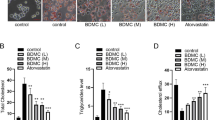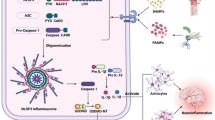Abstract
Atherosclerosis is an inflammatory disease. The NLRP3 inflammasome and miR-155 are significant components of inflammation and atherosclerosis. The aim of this research was to explore the possible mechanism by which miR-155 mediates the formation of carotid atherosclerotic plaques via the NLRP3 inflammasome. Fifty 6-week-old male ApoE−/− mice were randomly divided into 5 groups. They are the blank group, the negative control (NC) group, the miR-155 mimic group, the miR-155 inhibitor group, and the miR-155 mimic and ERK inhibitor group. The blood lipid levels were measured by the enzyme method Oil red O, HE, and immunohistochemical staining were used to observe the degree of carotid plaque formation. PCR was used to measure the expression of miR-155. The blood lipid levels were measured by the enzyme method. Western blotting was used to measure the expression of NLRP3 inflammasome-related proteins, interleukin-1β, interleukin-18, and MEK/ERK/NF-κB signaling pathway-related proteins. Compared with those of the NC group, the expression of miR-155 in the miR-155 mimic group increased significantly (P < 0.05), the degree of carotid plaque formation increased, the plasma levels of TC and LDL also increased significantly (P < 0.05); the expression levels of NLRP3 inflammasome-related proteins, interleukin-1β, interleukin-18, and MEK/ERK/NF-κB signaling pathway-related proteins were also significantly increased. Injection of ERK inhibitors into miR-155 mimic mice reduced the expression levels of p-NF-κB, NLRP3 inflammasome-related proteins, and inflammatory cytokines. In conclusion, miR-155 can promote the formation of atherosclerotic plaque in ApoE−/− mice, which may be achieved by regulating the MEK/ERK/NF-κB pathway to activate the NLRP3 inflammasome.
Highlights
• In ApoE−/− mice, miR-155 promotes atherosclerotic plaque formation.
• The NLRP3 inflammasome has an important role in the inflammatory process of atherosclerosis.
• miR-155 activates the NLRP3 inflammasome by regulating the MEK/ERK/NF-κB pathway in carotid atherosclerotic plaques of ApoE−/− mice.






Similar content being viewed by others
Abbreviations
- BCA:
-
Bicinchoninic acid
- DAMPs:
-
Danger-associated molecular patterns
- HDL:
-
High-density lipoprotein
- HE:
-
Hematoxylin-eosin
- IHC:
-
Immunohistochemical
- LDL:
-
Low-density lipoprotein cholesterol
- MAPK:
-
Mitogen-activated protein kinase
- MiRNAs:
-
MicroRNAs
- NC:
-
Negative control
- NF-κB:
-
Nuclear factor κ-light-chain-enhancer of activated B cells
- NLR:
-
NOD-like receptor
- NLRP3:
-
NOD-like receptor family pyrin domain containing 3
- PAMPs:
-
Pathogen-associated molecular patterns
- P-IL-1β:
-
Pro-interleukin-1β
- P-IL-18:
-
Pro-interleukin-18
- PRR:
-
Pattern recognition receptor
- RA:
-
Rheumatoid arthritis
- SDS-PAGE:
-
Sodium dodecyl sulfate-polyacrylamide gel electrophoresis
- SnRNA:
-
Small nuclear RNA
- TC:
-
Total cholesterol
- TG:
-
Triglyceride
- VSMCs:
-
Vascular smooth muscle cells
- GvHD:
-
Graft-versus-host disease
References
Alivernini S, Kurowska-Stolarska M, Tolusso B, Benvenuto R, Elmesmari A, Canestri S, Petricca L., Mangoni A, Fedele AL, Di Mario C (2016) MicroRNA-155 influences B-cell function through PU.1 in rheumatoid arthritis. Nature Communications 7:12970. https://doi.org/10.1038/ncomms12970
Artlett CM, Sassi-Gaha S, Hope JL, Feghali-Bostwick CA, Katsikis PD (2017) Mir-155 is overexpressed in systemic sclerosis fibroblasts and is required for NLRP3 inflammasome-mediated collagen synthesis during fibrosis. Arthritis Research & Therapy 19(1):1441–1448. https://doi.org/10.1186/s13075-017-1331-z
Baldrighi M, Mallat Z, Li X (2017) NLRP3 inflammasome pathways in atherosclerosis. Atherosclerosis 267:127–138. https://doi.org/10.1016/j.atherosclerosis.2017.10.027
Bauernfeind FG, Horvath G, Stutz A, Alnemri ES, MacDonald K, Speert D, Fernandes-Alnemri T, Wu J, Monks BG, Fitzgerald KA (2009) Cutting edge: NF-kappaB activating pattern recognition and cytokine receptors license NLRP3 inflammasome activation by regulating NLRP3 expression. Journal of Immunology 183:787–791. https://doi.org/10.4049/jimmunol.0901363
Boaru SG, Borkham-Kamphorst E, Van de Leur E, Lehnen E, Liedtke C, Weiskirchen R (2015) NLRP3 inflammasome expression is driven by NF-kappaB in cultured hepatocytes. Biochemical and Biophysical Research Communications 458:700–706. https://doi.org/10.1016/j.bbrc.2015.02.029
Carmi C et al (2010) Novel irreversible epidermal growth factor receptor inhibitors by chemical modulation of the cysteine-trap portion. J Med Chem 53:2038–2050. https://doi.org/10.1021/jm901558p
Chen S, Smith BA, Iype J, Prestipino A, Pfeifer D, Grundmann S, Schmitt-Graeff A, Idzko M, Beck Y, Prinz G (2015) MicroRNA-155-deficient dendritic cells cause less severe GVHD through reduced migration and defective inflammasome activation. Blood 126:103–112. https://doi.org/10.1182/blood-2014-12-617258
D'Espessailles A, Mora YA, Fuentes C, Cifuentes M (2018) Calcium-sensing receptor activates the NLRP3 inflammasome in LS14 preadipocytes mediated by ERK1/2 signaling. Journal of Cellular Physiology 233:6232–6240. https://doi.org/10.1002/jcp.26490
Dunand-Sauthier I, Santiago-Raber ML, Capponi L, Vejnar CE, Schaad O, Irla M, Seguin-Estevez Q, Descombes P, Zdobnov EM, Acha-Orbea H et al (2011) Silencing of c-Fos expression by microRNA-155 is critical for dendritic cell maturation and function. Blood 117:4490–4500. https://doi.org/10.1182/blood-2010-09-308064
Fann DY, Lim YA, Cheng YL, Lok KZ, Chunduri P, Baik SH, Drummond GR, Dheen ST, Sobey CG, Jo DG et al (2018) Evidence that NF-kappaB and MAPK signaling promotes NLRP inflammasome activation in neurons following ischemic stroke. Molecular Neurobiology 55:1082–1096. https://doi.org/10.1007/s12035-017-0394-9
Faraoni I, Antonetti FR, Cardone J, Bonmassar E (2009) MiR-155 gene: a typical multifunctional microRNA. Biochimica et Biophysica Acta 1792:497–505. https://doi.org/10.1016/j.bbadis.2009.02.013
Grebe A, Hoss F, Latz E (2018) NLRP3 inflammasome and the IL-1 pathway in atherosclerosis. Circulation Research 122:1722–1740. https://doi.org/10.1161/CIRCRESAHA.118.311362
Hansson GK, Hermansson A (2011) The immune system in atherosclerosis. Nature Immunology 12:204–212. https://doi.org/10.1038/ni.2001
Hoseini Z, Sepahvand F, Rashidi B, Sahebkar A, Masoudifar A, Mirzaei H (2018) NLRP3 inflammasome: its regulation and involvement in atherosclerosis. Journal of Cellular Physiology 233:2116–2132. https://doi.org/10.1002/jcp.25930
Hu S, Zhu W, Zhang LF, Pei M, Liu MF (2014) MicroRNA-155 broadly orchestrates inflammation-induced changes of microRNA expression in breast cancer. Cell Research 24:254–257. https://doi.org/10.1038/cr.2013.137
Li X, Kong D, Chen H, Liu S, Hu H, Wu T, Wang J, Chen W, Ning Y, Li Y (2016) miR-155 acts as an anti-inflammatory factor in atherosclerosis-associated foam cell formation by repressing calcium-regulated heat stable protein 1. Scientific Reports 6:21789. https://doi.org/10.1038/srep21789
Li P, Wang G, Zhang XL, He GL, Luo X, Yang J, Luo Z, Shen TT, Yang XS (2019) MicroRNA-155 promotes heat stress-induced inflammation via targeting liver x receptor α in microglia. Frontiers in Cellular Neuroscience 13:12. https://doi.org/10.3389/fncel.2019.00012
Liang S, Hu J, Zhang A, Li F, Li X (2020) Mir-155 induces endothelial cell apoptosis and inflammatory response in atherosclerosis by regulating bmal1. Experimental and Therapeutic Medicine 20:128. https://doi.org/10.3892/etm.2020.9259
Liu L, Dong Y, Ye M, Jin S, Yang J, Joosse ME, Sun Y, Zhang J, Lazarev M, Brant SR (2017) The pathogenic role of NLRP3 inflammasome activation in inflammatory bowel diseases of both mice and humans. Journal of Crohn's & colitis 11:737–750. https://doi.org/10.1093/ecco-jcc/jjw219
Murray CJ, Lopez AD (2013) Measuring the global burden of disease. The New England Journal of Medicine 369:448–457. https://doi.org/10.1056/NEJMra1201534
Nazari-Jahantigh M, Wei Y, Noels H et al (2021) MicroRNA-155 promotes atherosclerosis by repressing Bcl6 in macrophages. J Clin Invest 122:4190–4202. https://doi.org/10.1172/JCI61716
Paramel Varghese G, Folkersen L, Strawbridge RJ, Halvorsen B, Yndestad A, Ranheim T, Krohg-Sorensen K, Skjelland M, Espevik T, Aukrust P (2016) NLRP3 Inflammasome expression and activation in human atherosclerosis. Journal of the American Heart Association 5. https://doi.org/10.1161/JAHA.115.003031
Soh J, Iqbal J, Queiroz J, Fernandez-Hernando C, Hussain MM (2013) Microrna-30c reduces hyperlipidemia and atherosclerosis in mice by decreasing lipid synthesis and lipoprotein secretion. Nature Medicine 19:892–900. https://doi.org/10.1038/nm.3200
Sun HX, Zeng DY, Li RT, Pang RP, Yang H, Hu YL, Zhang Q, Jiang Y, Huang LY, Tang YB (2012) Essential role of microRNA-155 in regulating endothelium-dependent vasorelaxation by targeting endothelial nitric oxide synthase. Hypertension 60:1407–1414. https://doi.org/10.1161/HYPERTENSIONAHA.112.197301
Tarallo V, Hirano Y, Gelfand BD, Dridi S, Kerur N, Kim Y, Cho WG, Kaneko H, Fowler BJ, Bogdanovich S (2012) DICER1 loss and Alu RNA induce age-related macular degeneration via the NLRP3 inflammasome and MyD88. Cell 149:847–859. https://doi.org/10.1016/j.cell.2012.03.036
Vande Walle L, Van Opdenbosch N, Jacques P, Fossoul A, Verheugen E, Vogel P, Beyaert R, Elewaut D, Kanneganti TD, van Loo G (2014) Negative regulation of the NLRP3 inflammasome by A20 protects against arthritis. Nature 512:69–73. https://doi.org/10.1038/nature13322
Vickers KC, Landstreet SR, Levin MG, Shoucri BM, Toth CL, Taylor RC et al (2014) Microrna-223 coordinates cholesterol homeostasis. Proc Natl Acad Sci USA 111:14518–14523. https://doi.org/10.1073/pnas.1215767111
Wallace JA, Kagele DA, Eiring AM, Kim CN, Hu R, Runtsch MC, Alexander M, Huffaker TB, Lee SH, Patel AB (2017) MiR-155 promotes FLT3-ITD-induced myeloproliferative disease through inhibition of the interferon response. Blood 129:3074–3086. https://doi.org/10.1182/blood-2016-09-740209
Wang Z, Yang C, Li L, Jin X, Huang J (2020) Tumor-derived hmgb1 induces cd62ldim neutrophil polarization and promotes lung metastasis in triple-negative breast cancer. Oncogenesis 9:82. https://doi.org/10.1038/s41389-020-00267-x
Wang G, Chen JJ, Deng WY, Ren K, Yu XH (2021) Ctrp12 ameliorates atherosclerosis by promoting cholesterol efflux and inhibiting inflammatory response via the mir-155-5p/lxrα pathway. Cell Death & Disease 12. https://doi.org/10.1038/s41419-021-03544-8
Yang LX, Liu G, Zhu GF, Liu H, Guo RW, Qi F, Zou JH (2014) MicroRNA-155 inhibits angiotensin II-induced vascular smooth muscle cell proliferation. Journal of the renin-angiotensin-aldosterone system : JRAAS 15:109–116. https://doi.org/10.1177/1470320313503693
Yang Y, Yang L, Liang X, Zhu G (2015) MicroRNA-155 promotes atherosclerosis inflammation via targeting SOCS1. Cellular Physiology and Biochemistry 36:1371–1381. https://doi.org/10.1159/000430303
Yang Z, Zheng B, Zhang Y, He M, Zhang XH, Ma D, Zhang RN, Wu XL, Wen JK (2015) MiR-155-dependent regulation of mammalian sterile 20-like kinase 2 (MST2) coordinates inflammation, oxidative stress and proliferation in vascular smooth muscle cells. Biochimica et Biophysica Acta 1852:1477–1489. https://doi.org/10.1016/j.bbadis.2015.04.012
Yin R, Zhu X, Wang J, Yang S, Ma A, Xiao Q, Song J, Pan X (2019) MicroRNA-155 promotes the ox-LDLinduced activation of NLRP3 inflammasomes viathe ERK1/2pathway in THP-1 macrophages and aggravates atherosclerosisin ApoE−/− mice. Ann Palliat Med 8:676–689. https://doi.org/10.21037/apm.2019.10.11
Yue G, Mengmeng S et al (2016) Immunomodulatory effects of sulfated polysaccharides of pine pollen on mouse macrophages. International Journal of Biological Macromolecules Structure Function & Interactions. https://doi.org/10.1016/j.ijbiomac.2016.06.021
Acknowledgements
This project is based on the item subsidized by the National Key R&D Program of China (No. 2017YFC1310903) and the National Natural Sciences Foundation of China (No. 81771259 and No.81971111).
Author information
Authors and Affiliations
Contributions
AM: conceptualization and supervision. XP: methodology and conceptualization. QP: investigation, methodology, and writing-original draft. RY: investigation and formal analysis. XZ: writing-reviewing and editing. LJ: formal analysis and resources. JW: resources. The authors declare that all data were generated in-house and that no paper mill was used.
Corresponding authors
Ethics declarations
Ethics approval
Our study followed the guidelines for the care and use of animals.
Informed consent
All authors involved in the study accept the contents of the manuscript and consent to the submission of the work.
Conflict of interest
The authors declare no competing interests.
Additional information
Publisher’s note
Springer Nature remains neutral with regard to jurisdictional claims in published maps and institutional affiliations.
Rights and permissions
About this article
Cite this article
Peng, Q., Yin, R., Zhu, X. et al. miR-155 activates the NLRP3 inflammasome by regulating the MEK/ERK/NF-κB pathway in carotid atherosclerotic plaques in ApoE−/− mice. J Physiol Biochem 78, 365–375 (2022). https://doi.org/10.1007/s13105-022-00871-y
Received:
Accepted:
Published:
Issue Date:
DOI: https://doi.org/10.1007/s13105-022-00871-y




